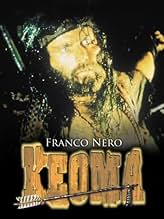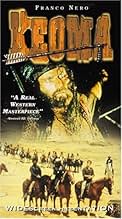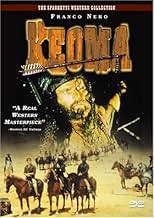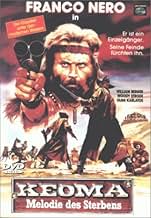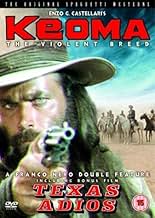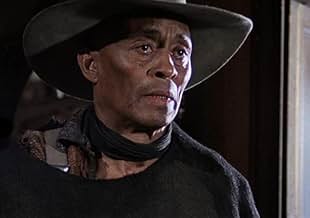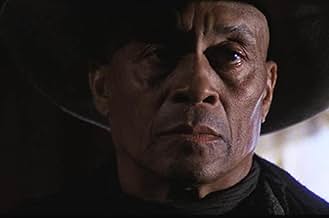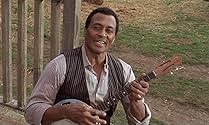VALUTAZIONE IMDb
7,0/10
6566
LA TUA VALUTAZIONE
Un pistolero mezzosangue ex unionista cerca di proteggere la sua città natale, colpita dalla peste, dalle prevaricazioni dei suoi fratellastri razzisti e di un tiranno della Confederazione.Un pistolero mezzosangue ex unionista cerca di proteggere la sua città natale, colpita dalla peste, dalle prevaricazioni dei suoi fratellastri razzisti e di un tiranno della Confederazione.Un pistolero mezzosangue ex unionista cerca di proteggere la sua città natale, colpita dalla peste, dalle prevaricazioni dei suoi fratellastri razzisti e di un tiranno della Confederazione.
- Regia
- Sceneggiatura
- Star
Joshua Sinclair
- Sam Shannon
- (as John Loffredo)
Donald O'Brien
- Caldwell
- (as Donald O'Brian)
Leonardo Scavino
- Doctor
- (as Leon Lenoir)
Antonio Basile
- Caldwell's Henchman
- (non citato nei titoli originali)
Giovanni Bonadonna
- Caldwell's Henchman
- (non citato nei titoli originali)
Armando Bottin
- Caldwell's Henchman
- (non citato nei titoli originali)
Aldo Canti
- Wagon Fugitive
- (non citato nei titoli originali)
- …
Felice Ceciarelli
- Caldwell's Henchman
- (non citato nei titoli originali)
Recensioni in evidenza
Though to be clear I wouldn't go as far as to call it "the best". Something the people involved are quick to point out or to. This is really good and you have a very charismatic (and hairy chested) Franco Nero starring. You also have supernatural elements, that may not be fully explained (not even by all the extras on the disc).
And you have old school shooutous, where bad guys seem to only need one bullet to bite the dust (literally), whereas good people have to be shot quite a few times mostly. So yes there are things that may seem or feel dated, but the overall sense is quite great. Not to mention the performances. Really telling and really inspired overall.
And you have old school shooutous, where bad guys seem to only need one bullet to bite the dust (literally), whereas good people have to be shot quite a few times mostly. So yes there are things that may seem or feel dated, but the overall sense is quite great. Not to mention the performances. Really telling and really inspired overall.
Talk to most Spaghetti Western fans and they will declare Keoma to be one of the finest of the genre's movies, and probably the best of the latter day ones. However they will also most probably comment on the atrocious soundtrack, which does take some getting used to. I honestly believe that if this movie had been given the Morricone touch, it would be firmly cemented as a true Spaghetti classic, standing side by side with The Big Gundown, Face to Face and Bullet for the General.
Aside from Django, this is Franco Nero's best role. A half breed venger, riding into a town decimated by both the plague and a gang of racist ex-Confederates, which includes his three hateful "brothers" in their ranks. There are also fine turns by William Berger as Keoma's adopted father Shannon, and Woody Strode as Keoma's childhood hero turned drunk, George.
As always, Castellari has injected true class into this film, with slow motion shootouts, effective flashbacks and clever camera tricks. This film is a true fitting end to the Spaghetti hay day, which had begun to loose its charm due to the ever increasing stupidity of the comedy westerns. The only negative aspect is that wretched soundtrack. Oh where was Morricone when we really needed him?
Aside from Django, this is Franco Nero's best role. A half breed venger, riding into a town decimated by both the plague and a gang of racist ex-Confederates, which includes his three hateful "brothers" in their ranks. There are also fine turns by William Berger as Keoma's adopted father Shannon, and Woody Strode as Keoma's childhood hero turned drunk, George.
As always, Castellari has injected true class into this film, with slow motion shootouts, effective flashbacks and clever camera tricks. This film is a true fitting end to the Spaghetti hay day, which had begun to loose its charm due to the ever increasing stupidity of the comedy westerns. The only negative aspect is that wretched soundtrack. Oh where was Morricone when we really needed him?
This film has so much that works so well, it's a shame one thing keeps it from working entirely l: the music. The single most annoying song I've ever heard in a film. Secondly the newest "restored" version inexplicably has two totally different English voices dubbed for Nero. His first few lines are delivered in a deep clear "radio announcer" pure English baritone, the rest of the film is in a poorly faked accent. What exactly would be the reason for this? Other than those two distractions, a great late era entry to the genre.
Director Castellari is nowadays perhaps best-known (if at all) by the younger generation of film buffs for one thing: making the original INGLORIOUS BASTARDS (1977), which Quentin Tarantino has been threatening to remake for years now. However, in my opinion, he should instead be remembered for making this impressive, belated Spaghetti Western gem.
An odd blend of violent action and heady mysticism apparently concocted by one of the credited screenwriters Luigi Montefiori (better known to hardened Euro-Cult fans as an actor under the alias of George Eastman) but, as star Franco Nero and Castellari himself state in the Anchor Bay DVD supplements, the script took so long to get written that they decided to work without one and make the dialogue up as they went along! That the end result is so satisfying (and practically unique in the subgenre) is a remarkable achievement in itself.
Keoma is a half-breed returning home from the American Civil War to find his hometown ravaged by the plague and overtaken by the villainous Caldwell (Donal O' Brien); among his cohorts are Nero's three half-brothers who had made his childhood a living hell, with his surrogate father (William Berger) and colored mentor turned banjo-playing town-drunk (Woody Strode) unable to do much to counter Caldwell's oppression. A Bergmanesque, cadaverous old woman is frequently seen roaming the streets dragging a cart behind her...
What follows is the typical confrontation between Good and Evil but Castellari infuses the familiar mixture with several directorial flourishes: occasionally striking compositions (particularly a memorably Fordian opening shot), frequent use of slow-motion in true Peckinpah-style, flashbacks in which Keoma is a spectator to his own past experiences (inspired by Elia Kazan's THE ARRANGEMENT [1969]!), a touch of elliptical editing, Christian symbolism (Keoma is crucified at one point) and, most distressingly of all, a folksy soundtrack (inspired by Leonard Cohen and Bob Dylan, no less and warbled...er...sung by a shrill, high-pitched female singer and an out-of-tune deep-voiced male) which narrates in song the action we're seeing on the screen. I say distressingly because the Guido and Maurizo De Angelis compositions found here have forever been a thorn in the side of even the film's staunchest admirers!! Personally, I didn't mind the female singer so much after a while but when her (possibly drunk) male companion took over in the last half hour, I was in for some cringe-inducing moments for sure...!
Despite these misgivings, the film is still one of the best Spaghetti Westerns out there (and certainly the last great example of the subgenre); its undoubted highlight is provided by a terrific, lovingly protracted action set-piece in which Nero, Berger and a reformed Strode (back to his former arrow-shooting glory - perhaps a nod to the role he played in Richard Brooks' splendid THE PROFESSIONALS [1966]) wipe out most of Caldwell's gang. Their triumph is short-lived, however, because both Berger and Strode lose their lives in the ongoing struggle (Berger poignantly so, while Strode's death scene is particularly great), with Nero almost bowing out himself under the strain of his siblings' torture - who have subsequently disposed of Caldwell and taken over the town themselves; the final confrontation, then, between Keoma and his three half-brothers is eerily set to the "strains" of Olga Karlatos' (playing a woman Keoma had earlier on saved from a plague-infested colony) wailing and screaming as she lies giving birth to a child amidst the carnage!
While at first I was disappointed that the Anchor Bay DVD only included the English dub, having watched it now it seems clear that the actors were all speaking their dialogue in English on the set - although, as connoisseurs will certainly know, this was all re-recorded back in the studios anyway (as was common practice in the Italian film industry). Still, if ever it gets shown again on Italian TV, I'll be sure to check it out just for completeness' sake. Thankfully, however, Castellari contributes a highly enthusiastic and informative Audio Commentary in which he discusses his major influences while making the film, among them Sidney J. Furie's THE APPALOOSA (1966), Altman's McCABE AND MRS. MILLER (1971) and Peckinpah's PAT GARRETT AND BILLY THE KID (1973).
Ultimately, Franco Nero in the title role is almost as iconic a figure as Django and, hopefully, I should be getting to another fairly obscure but highly intriguing Spaghetti Westen of his - Luigi Bazzoni's MAN, PRIDE AND VENGEANCE (1968), an eccentric updating of Georges Bizet's opera "Carmen", co-starring Klaus Kinski and Tina Aumont - pretty soon...
An odd blend of violent action and heady mysticism apparently concocted by one of the credited screenwriters Luigi Montefiori (better known to hardened Euro-Cult fans as an actor under the alias of George Eastman) but, as star Franco Nero and Castellari himself state in the Anchor Bay DVD supplements, the script took so long to get written that they decided to work without one and make the dialogue up as they went along! That the end result is so satisfying (and practically unique in the subgenre) is a remarkable achievement in itself.
Keoma is a half-breed returning home from the American Civil War to find his hometown ravaged by the plague and overtaken by the villainous Caldwell (Donal O' Brien); among his cohorts are Nero's three half-brothers who had made his childhood a living hell, with his surrogate father (William Berger) and colored mentor turned banjo-playing town-drunk (Woody Strode) unable to do much to counter Caldwell's oppression. A Bergmanesque, cadaverous old woman is frequently seen roaming the streets dragging a cart behind her...
What follows is the typical confrontation between Good and Evil but Castellari infuses the familiar mixture with several directorial flourishes: occasionally striking compositions (particularly a memorably Fordian opening shot), frequent use of slow-motion in true Peckinpah-style, flashbacks in which Keoma is a spectator to his own past experiences (inspired by Elia Kazan's THE ARRANGEMENT [1969]!), a touch of elliptical editing, Christian symbolism (Keoma is crucified at one point) and, most distressingly of all, a folksy soundtrack (inspired by Leonard Cohen and Bob Dylan, no less and warbled...er...sung by a shrill, high-pitched female singer and an out-of-tune deep-voiced male) which narrates in song the action we're seeing on the screen. I say distressingly because the Guido and Maurizo De Angelis compositions found here have forever been a thorn in the side of even the film's staunchest admirers!! Personally, I didn't mind the female singer so much after a while but when her (possibly drunk) male companion took over in the last half hour, I was in for some cringe-inducing moments for sure...!
Despite these misgivings, the film is still one of the best Spaghetti Westerns out there (and certainly the last great example of the subgenre); its undoubted highlight is provided by a terrific, lovingly protracted action set-piece in which Nero, Berger and a reformed Strode (back to his former arrow-shooting glory - perhaps a nod to the role he played in Richard Brooks' splendid THE PROFESSIONALS [1966]) wipe out most of Caldwell's gang. Their triumph is short-lived, however, because both Berger and Strode lose their lives in the ongoing struggle (Berger poignantly so, while Strode's death scene is particularly great), with Nero almost bowing out himself under the strain of his siblings' torture - who have subsequently disposed of Caldwell and taken over the town themselves; the final confrontation, then, between Keoma and his three half-brothers is eerily set to the "strains" of Olga Karlatos' (playing a woman Keoma had earlier on saved from a plague-infested colony) wailing and screaming as she lies giving birth to a child amidst the carnage!
While at first I was disappointed that the Anchor Bay DVD only included the English dub, having watched it now it seems clear that the actors were all speaking their dialogue in English on the set - although, as connoisseurs will certainly know, this was all re-recorded back in the studios anyway (as was common practice in the Italian film industry). Still, if ever it gets shown again on Italian TV, I'll be sure to check it out just for completeness' sake. Thankfully, however, Castellari contributes a highly enthusiastic and informative Audio Commentary in which he discusses his major influences while making the film, among them Sidney J. Furie's THE APPALOOSA (1966), Altman's McCABE AND MRS. MILLER (1971) and Peckinpah's PAT GARRETT AND BILLY THE KID (1973).
Ultimately, Franco Nero in the title role is almost as iconic a figure as Django and, hopefully, I should be getting to another fairly obscure but highly intriguing Spaghetti Westen of his - Luigi Bazzoni's MAN, PRIDE AND VENGEANCE (1968), an eccentric updating of Georges Bizet's opera "Carmen", co-starring Klaus Kinski and Tina Aumont - pretty soon...
I have to pretty much agree with the two negative reviews below, and I'll explain why in a minute.
Franco Nero plays "Keoma" a half-breed Indian raised by a white man named Shannon (William Berger) who also has three sons (adoptive brothers of Keoma) who hate him and have never accepted a 'half-breed' as their brother.
There's also George (Woody Strode), an ex-slave and friend of Shannon's who teaches Keoma all he knows about fighting.
Cut 20 years later after some flashbacks and Keoma returns to the town near where he was raised and finds that a plague has engulfed the town with a quarantine imposed by a wealthy mine owner Caldwell (Donald O'Brien) who would just as soon have it's inhabitants all die off so he can fully control the area. Keoma steps in to save a pregnant woman who Caldwell's men suspect as a plague carrier and all hell breaks loose.
Yeah, some of the knife throwing does look ludicrous, but the fist fights look good and there's an excellent gun battle in town between Keoma, Shannon and George vs. Caldwell's men. It's really done well and it looks like it was filmed in the same western set built outside of Rome as DJANGO was ten years earlier. By this time though, the place looks pretty run down and cluttered which makes a good setting for a plague-infested town.
As far as negatives go, the music sucks. It's an annoying high pitch (mostly female) whine that appears periodically throughout the move, inter sprinkled with 'singing' done by Franco Nero himself. It sounds awful as he tries to imitate Leonard Cohen but winds up sounding like a lame Tom Waits. I don't know why anybody likes it. To each his own, I guess.
There's also the annoying Sam Peckinpah-like slow-motion effects that become a cliché used over and over. It ruins some of the great gunfights, especially at the end where Keoma is battling his brothers in a barn while the pregnant lady's screams drown out all the gun battle sound. A little too arty for my tastes.
The dubbing is OK and it sounds like Nero dubbed in his own voice which comes off as strange and foreign for a half-breed American Indian. I suppose one gets used to it as the film goes along.
The Anchor Bay DVD uses an anamorphic widescreen print that looks pretty good. Only a few scratches during the opening and closing titles. No closed captioning. Nero also does a 10 minute interview explaining how the film came about, along with a secondary audio track by director Enzo Castellari giving details about the filming. Yeah the spaghetti western genre was dead by the time this film was made, but Castellari says it did very well in Italy although not enough to revive the genre. Tastes were moving towards gangsters and crime dramas by the mid-70s, so this film was an exception, not the rule.
It has some good ideas but I wouldn't consider it a masterpiece for the genre or anything. However I did enjoy some of the gun play and fistfights.
6 out of 10
-
Franco Nero plays "Keoma" a half-breed Indian raised by a white man named Shannon (William Berger) who also has three sons (adoptive brothers of Keoma) who hate him and have never accepted a 'half-breed' as their brother.
There's also George (Woody Strode), an ex-slave and friend of Shannon's who teaches Keoma all he knows about fighting.
Cut 20 years later after some flashbacks and Keoma returns to the town near where he was raised and finds that a plague has engulfed the town with a quarantine imposed by a wealthy mine owner Caldwell (Donald O'Brien) who would just as soon have it's inhabitants all die off so he can fully control the area. Keoma steps in to save a pregnant woman who Caldwell's men suspect as a plague carrier and all hell breaks loose.
Yeah, some of the knife throwing does look ludicrous, but the fist fights look good and there's an excellent gun battle in town between Keoma, Shannon and George vs. Caldwell's men. It's really done well and it looks like it was filmed in the same western set built outside of Rome as DJANGO was ten years earlier. By this time though, the place looks pretty run down and cluttered which makes a good setting for a plague-infested town.
As far as negatives go, the music sucks. It's an annoying high pitch (mostly female) whine that appears periodically throughout the move, inter sprinkled with 'singing' done by Franco Nero himself. It sounds awful as he tries to imitate Leonard Cohen but winds up sounding like a lame Tom Waits. I don't know why anybody likes it. To each his own, I guess.
There's also the annoying Sam Peckinpah-like slow-motion effects that become a cliché used over and over. It ruins some of the great gunfights, especially at the end where Keoma is battling his brothers in a barn while the pregnant lady's screams drown out all the gun battle sound. A little too arty for my tastes.
The dubbing is OK and it sounds like Nero dubbed in his own voice which comes off as strange and foreign for a half-breed American Indian. I suppose one gets used to it as the film goes along.
The Anchor Bay DVD uses an anamorphic widescreen print that looks pretty good. Only a few scratches during the opening and closing titles. No closed captioning. Nero also does a 10 minute interview explaining how the film came about, along with a secondary audio track by director Enzo Castellari giving details about the filming. Yeah the spaghetti western genre was dead by the time this film was made, but Castellari says it did very well in Italy although not enough to revive the genre. Tastes were moving towards gangsters and crime dramas by the mid-70s, so this film was an exception, not the rule.
It has some good ideas but I wouldn't consider it a masterpiece for the genre or anything. However I did enjoy some of the gun play and fistfights.
6 out of 10
-
Lo sapevi?
- QuizThe story line of the film was mostly improvised at the same time as the film was made. The original story treatment was written by Luigi Montefiori (aka George Eastman) and turned into a script by Mino Roli and Nico Ducci, but director Enzo G. Castellari didn't like what had been written by the latter two. Because of problems with the schedule, Castellari and actor Joshua Sinclair wrote the script for the next day every evening after filming of the day. Castellari was also open to suggestions from the cast and crew - Franco Nero has confirmed that he wrote some of his own dialogue.
- BlooperAt 7:08 riders on horseback in pursuit of two men running on foot fire their pistols. Both men on foot react as if hit by the first shot.
- Versioni alternativeGerman version was cut for violence and pacing reasons by 8 minutes to secure a "not under 16" rating. Despite that, it still got put on the index list by the BPjM which means various sales and advertising restrictions. Fortunately in 2003, the movie was removed from the index list and the FSK granted the uncut version a "not under 16" rating.
- ConnessioniFeatured in L'Oeil du cyclone: Westernissimo (1995)
- Colonne sonoreKeoma
(uncredited)
Music by Guido De Angelis & Maurizio De Angelis
Lyrics by Susan Duncan Smith and Cesare De Natale
Performed by Sibyl Mostert and Cesare De Natale
I più visti
Accedi per valutare e creare un elenco di titoli salvati per ottenere consigli personalizzati
- How long is Keoma?Powered by Alexa
Dettagli
Contribuisci a questa pagina
Suggerisci una modifica o aggiungi i contenuti mancanti



